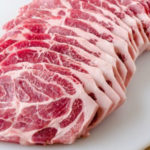Don’t trim the fat before boiling

Many people have the habit of buying meat and immediately boiling it without trimming the fat. This habit causes the meat to cook unevenly, with the outside being soft while the inside remains raw.
To ensure that the boiled meat is cooked evenly, cut the meat into evenly sized cubes of moderate thickness. Before boiling, scrape off any remaining hair from the skin, rub the meat with lemon and coarse salt, and then rinse thoroughly. Lemon and salt effectively remove any unwanted smell, while citric acid and vitamin C help enhance the meat’s fragrance and freshness.
For boiled meat, it is best to choose pork belly (alternating layers of lean meat and fat) or pork hock. If you prefer lean meat (tenderloin), soak it in a brine solution before rinsing and boiling. This helps keep the meat moist and prevents it from drying out.
Poking and flipping the meat multiple times during boiling
A common method to check if the meat is cooked is to poke it with a chopstick. However, do not be too hasty in poking or flipping the meat multiple times while boiling or frying, as this will cause the juices and flavors to escape, resulting in dry and tasteless meat.
Adding cold water during boiling
Adding cold water to a pot of boiling water is a common mistake made by many when boiling meat. The sudden drop in temperature causes the protein and fat to coagulate immediately, making the meat tough and difficult to soften. The lean part of the meat will become harder, and its fresh flavor will be affected. Instead, ensure that the water level covers the meat, and if you need to add more water, use boiling water.
Overboiling

To ensure that the meat is thoroughly cooked, many people tend to overboil it. However, this causes the lean meat to dry out, and if boiled for much longer, the entire piece of meat becomes mushy and loses its sweetness, leading to quicker satiation.
Overboiling meat also affects its nutritional value. According to experts, at temperatures between 200 and 300 degrees Celsius, amino acids, creatinine, sugars, and harmless compounds in the meat undergo chemical reactions, forming some harmful compounds.
Therefore, when boiling meat, it is best to cook it just right—this way, the meat retains its sweetness, fragrance, and crisp texture.
Slicing the meat immediately after boiling

To ensure the meat stays hot, many people slice it immediately after boiling. However, this is a mistake, as the meat is still soft and mushy at this point, making it difficult to slice neatly. Instead, place the boiled meat in a bowl of cold water for about a minute before slicing. This way, the meat will remain warm, taste better, and look more appealing.
Tips for delicious boiled meat
To ensure the best-tasting boiled meat, select the right cut of meat. Ideally, choose pork belly, pork hock, head meat, or shoulder meat, depending on your preference. Opt for a piece with a good balance of lean meat and fat so that the sliced meat looks attractive.
Add a pinch of salt to a pot of water, ensuring it is enough to submerge the meat. Place the cleaned meat in the pot and boil it over medium heat. Once the water starts to boil, remove the meat, discard the water, and rinse it again before boiling it again. Add a small amount of salt, vinegar, and crushed onion to the water to eliminate any unwanted smell.
To ensure the meat is cooked perfectly, avoid using too large a piece, as it may not cook evenly. If you have a large, thick piece of meat, score it to allow even cooking. The boiling time will depend on the size of the meat, typically ranging from 15 to 25 minutes.
During the boiling process, skim off any foam that forms on the surface to ensure clear broth and more appealing-looking meat.
After removing the meat from the pot, immediately place it in a bowl of cold water (enough to submerge the meat) and let it cool completely before removing and slicing. This process helps the meat retain its bright pink color and prevents it from becoming mushy.
Note: If you are boiling tenderloin, pay extra attention to the cooking time, as overboiling will result in dry and crumbly meat. Tenderloin is best enjoyed slightly rare and still warm, as it will be tender, sweet, and suitable for those on a diet.
According to Nguoiduatin
Revealing the Secrets of Delicious Cooking by a Professional Chef
Are you looking to become the master chef of your home kitchen? Ði?n máy XANH is here to help with their tips on how to serve up restaurant-level dishes, from proper cooking methods for meat and grilling, to baking delicious cakes. So pick up your apron and get ready to show off your culinary prowess!






































